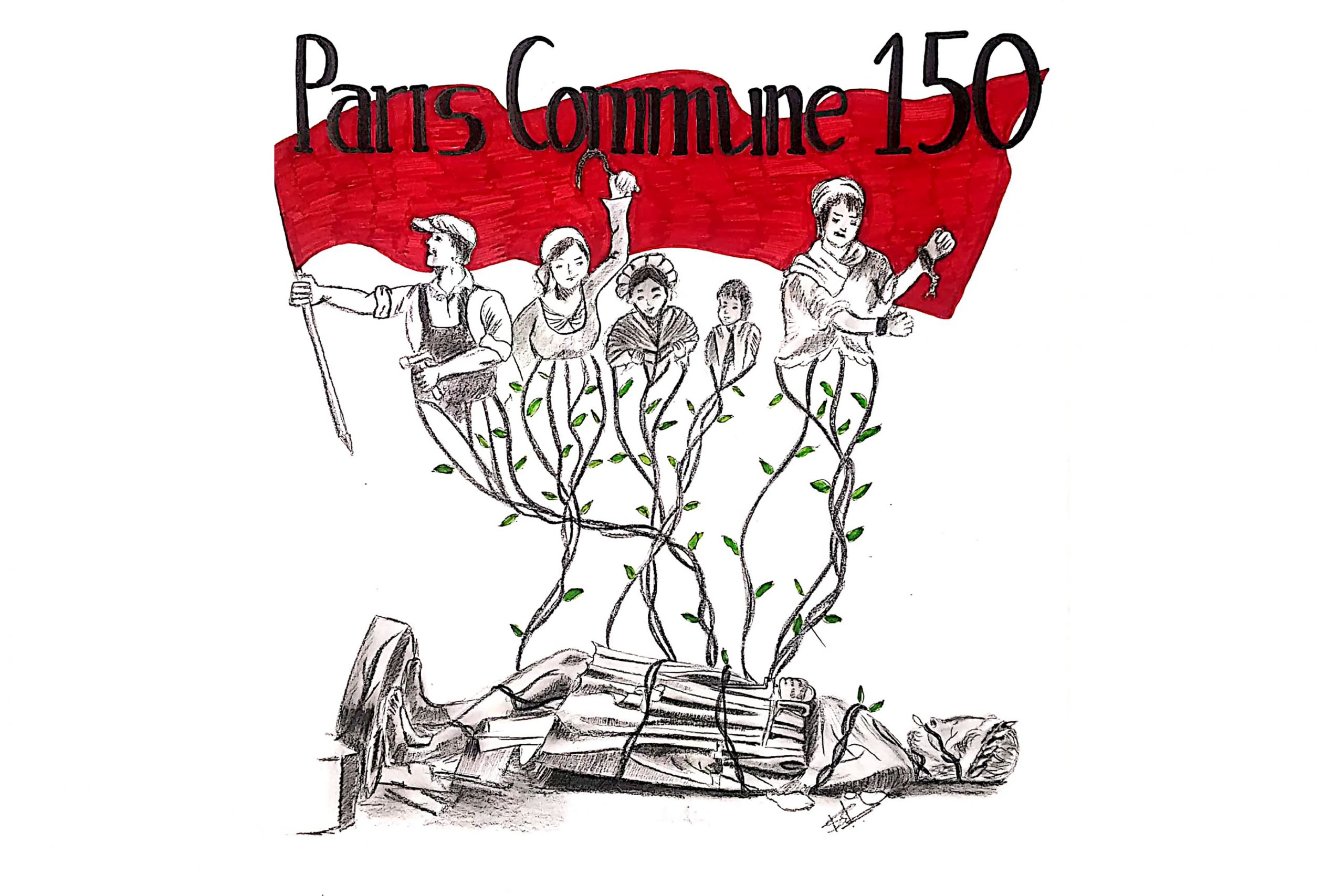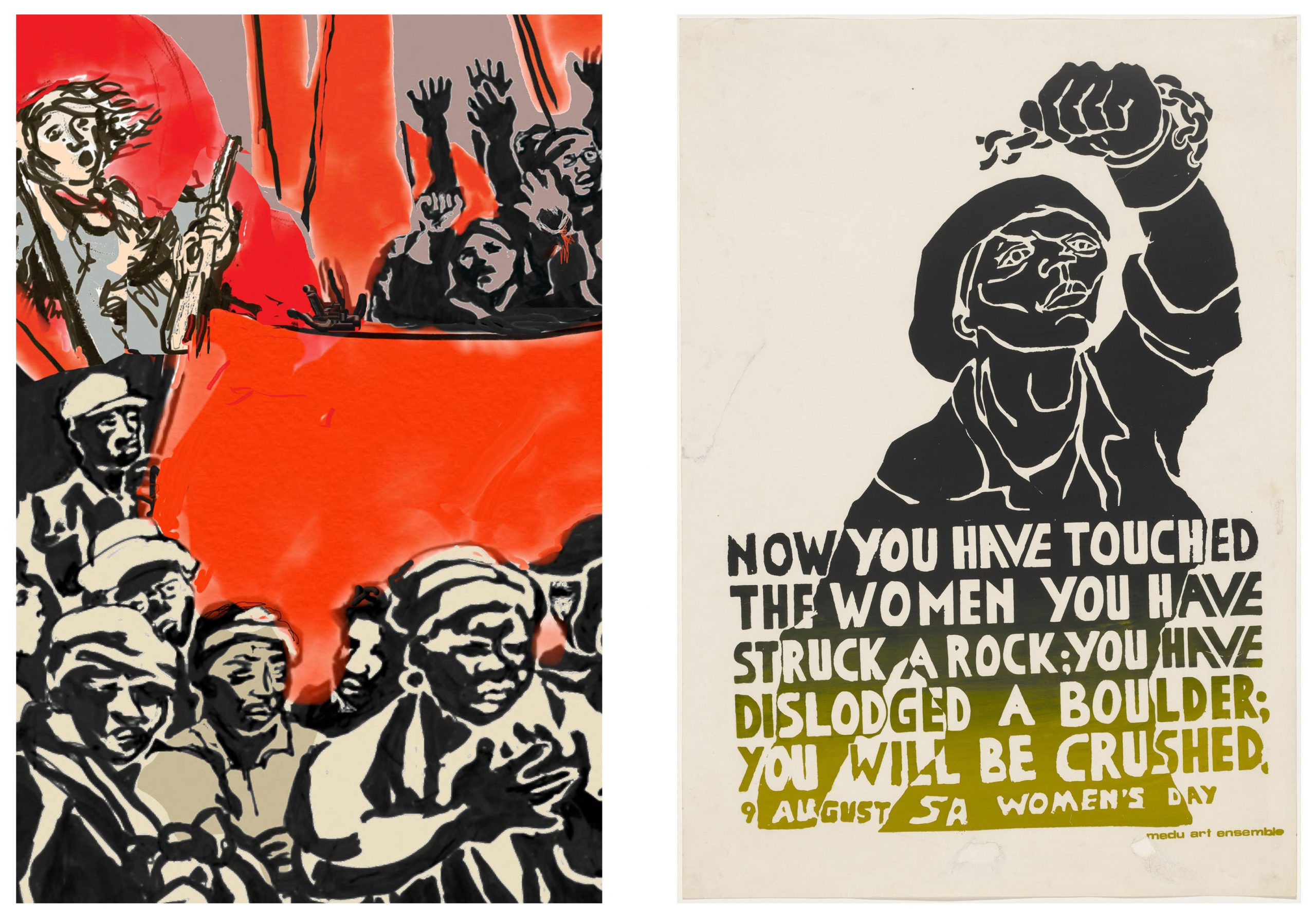Post-poster: Subversive art in the digital age
A recent exhibition marking 150 years since the Paris Commune’s short-lived control of the city raises questions about the socio-political role of visual artworks today.
Author:
14 June 2021

Generations of adolescents the world over have been pulling centre-page posters from magazines and pasting them on any wall that’s suitable or available. These days, posters don’t fade because of their exposure to ultraviolet rays and they don’t curl in on themselves at the edges with age. Today’s digital pixel posters are shared online and maintain their condition as long as they exist. Timestamps and internet-based platforms are their provenance. But even in this digital age, they remain important tools for punctuating, archiving and remembering.
There is a distinct poster quality to most of the works included in the recent Paris Commune 150 online group exhibition. The difference is that instead of featuring a cherished musician or band, sportsperson or model, superhero or cartoon figure, the subject of these posters is collective and communal.


Created by the international social research institute Tricontinental, the Paris Commune 150 exhibition has contributions from 41 visual artists from 15 countries. It exists alongside a publication of the same name that has been translated into 18 languages.
The bulk of the book’s 108 pages is dedicated to seminal texts by German philosopher Karl Marx (The Civil War in France), former Soviet Union premier Vladimir Lenin (The State of Revolution, Chapter III) and German playwright Bertold Brecht (Resolution of the Communards), and there is a notable introduction by Indian historian and Tricontinental director Vijay Prashad.
The musical notation for the left-leaning and anarchist movements’ anthem, L’Internationale, appears amid the essays, with excerpts of the lyrics translated from the original French into various languages, including English and Spanish.


Both the exhibition and the book memorialise 150 years since the Paris Commune’s (La Commune de Paris) 72-day-long, worker-led governance of the city after France’s defeat in the war against Prussia. An early attempt at such governance, the Paris Commune began on 18 March 1871. The city’s workers had been armed, as the National Guard, to defend it against Prussian forces.
When France lost the war, the forces of the newly established French Third Republic led by president Adolphe Thiers tried to take control of the cannons that had defended Paris against Prussian soldiers. National Guard soldiers successfully defended these cannons and with that began the 72-day Paris Commune governance of the city.
Reimagining history for today
Designer Tings Chak, a researcher at Tricontinental, says the exhibition began with a global call for artists to contribute work that “helped reimagine and visualise the commune’s history and what it means today for people’s struggles and movements”. The individual works, the exhibition and the publication highlight how visual art can have historical, subversive and personal significance simultaneously. The artistic treatments were not uniform, however.
Some artists’ work is nuanced and abstract. Others took a literal approach, using words and established communist iconography to convey their messages. As such, the red flag, the most recognisable icon of leftist politics, features prominently throughout the works. It was raised by the workers in the first few hours of the Paris Commune’s short-lived existence.


The Commune’s contribution to subsequent leftist philosophy and revolutions is difficult to overstate. Lenin is said to have danced in the snow on the 73rd day of the Bolshevik Revolution, celebrating that the Soviet experiment, at that point, had outlasted the Paris Commune’s.
But the Paris Commune 150 exhibition is not all red flags, hammers and sickles, raised fists and “the workers”. The most striking images in the exhibition are those that, in part or wholly, snub leftist iconographies in pursuit of something greater than yearning for a glorious era in an art-political fever dream of misplaced nostalgia.


United States-born and South Africa-based visual artist Judy Seidman’s untitled contribution gets its depth partly from its depiction of a concert of emotions and the grey areas that are the lived reality of revolutions. In her image, a raised fist is backgrounded by open hands that could be pleading or desperate. A hand clutches a rifle in the top left-hand corner, while two hands press against a breast at the bottom right-hand corner. Are those flags or flames that surround the characters in the painting?
From 1980 to 1985, Seidman worked with the Medu Art Ensemble, an anti-apartheid and anti-imperialist arts collective based in Botswana. As one of the collective’s culture workers in visual arts, Seidman produced and helped to produce myriad subversive posters clandestinely, such as the widely recognisable Struck a Rock.
Linking art to struggle
In exile in Botswana, Harry Thamsanqa Mnyele, Medu’s visual arts founding member, wrote the telling words that would only be published 15 years after South Africa’s first democratic election: “It is my contention that the strife and struggle that manifests itself in the arts is subject to, and linked with, the broad socio-political struggle at home [South Africa], and indeed in the world internationally. What it means is that whatever artistic indulgence we engage ourselves in must not be blind to the river of life within and around us, that social stream from which art feeds and is nourished: the community.”
Thirty-six years after South African Defence Force soldiers shot and killed Mnyele outside his home in Gaborone and Medu was disbanded, in 1985, Seidman still finds value in the poster medium. “One of the reasons for doing posters is that it’s another way of getting images out that will be seen by people you want to talk to.”


She says the poster still has a role to play in the digital age. “I do think we need to rethink its role in terms of social media. The assumption [is] that posters would be put up on walls, which is what happened in the 1980s, of course, [as] that was the major distribution mechanism that was available. It still remains a good distribution mechanism. But honestly, I’m not sure [of] the alternatives in terms of social media. I think we should think about how we use them.”
There is trepidation in her voice when Seidman talks about the socio-political role art plays in the digital age, in which social media dominates and sometimes determines social discourse. She “doesn’t have any good answers”, she says.
Looking past and not at images
The age of public walls bearing the remnants of posters removed or weathered is being replaced. The infinity scroll allows viewers access to a seemingly endless flow of images to look past, decreasing the number of images they look at. Some might say that Mnyele’s “river of life” is drying up, with the personal being increasingly more important than the communal for many.
Revolutions are delicate, precarious events thrust into existence mainly by the hopes of the many over those of the few. Visual art has played an indelible role in the South African struggle for democracy in various ways. The posters Medu created were a literal interpretation of that role. They exist alongside photography, painting, sculpture and other visual art forms by artists who literally or figuratively – or both – contributed to the cause against apartheid.
The Paris Commune 150 exhibition, with its poster-like quality in much of the works included, smacks of nostalgia for revolution without outrightly addressing the question of who the audiences for these works are meant to be. If a viewer feels sufficiently moved by the works and the cause, where and how are they meant to take it further? The book’s translation, the low-to-no cost of acquiring a copy and it being available online goes a long way in reaching the “people you want to talk to” at the receiving end, at least as far as Seidman’s work is concerned.


Advertisements for penis enlargement herbs, pest extermination services and promises to “bring back lost lover” are the most pervasive use of posters in South African cities and towns. Public visual art, although safe in the hands of the country’s graffiti artists, has lost much of the subversive and communal ethos of the 1970s and 1980s.
The South African commercial gallery system exists in antithesis to anything freely accessible by most of the population. Excluded from participating in “high art”, flanked by the beautiful and grotesque, South Africans walk the streets savouring and unseeing. Faced with conditions that threaten the foundations of visual arts that pursue progress in society, answers are few but anxiety will not stick. This is no time for trepidation.
